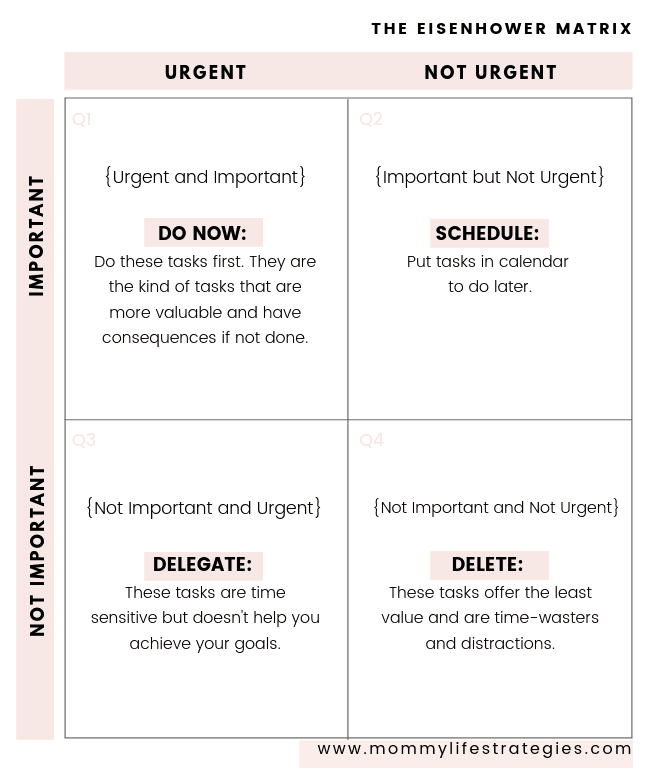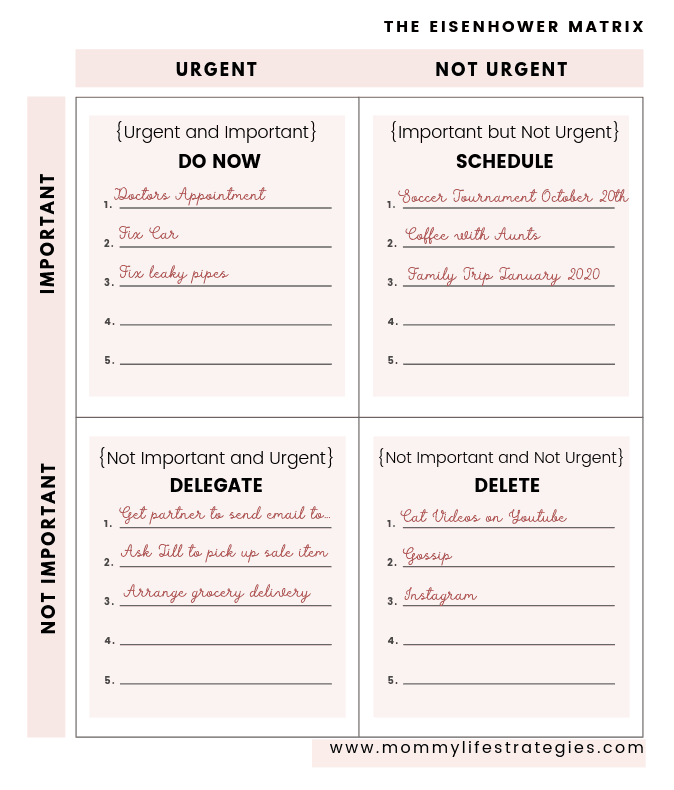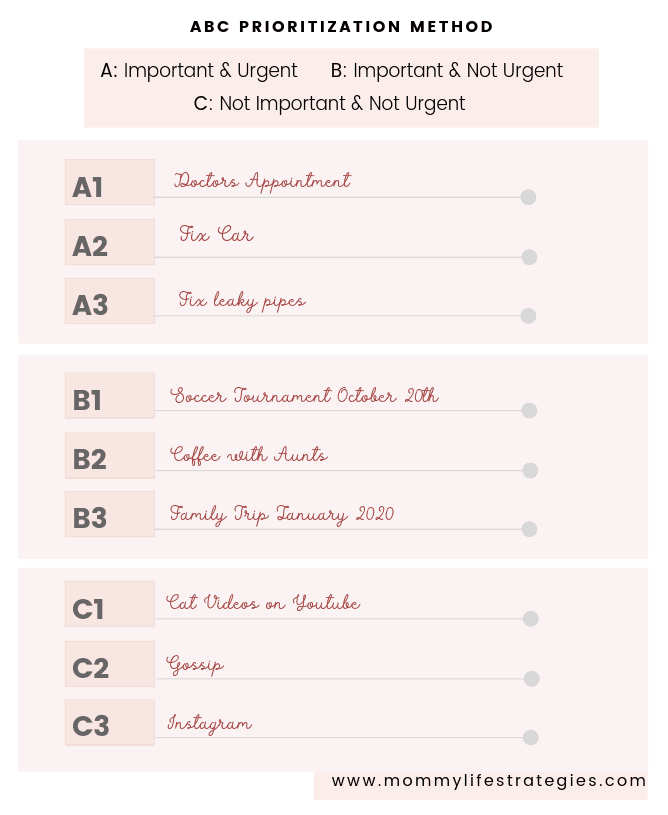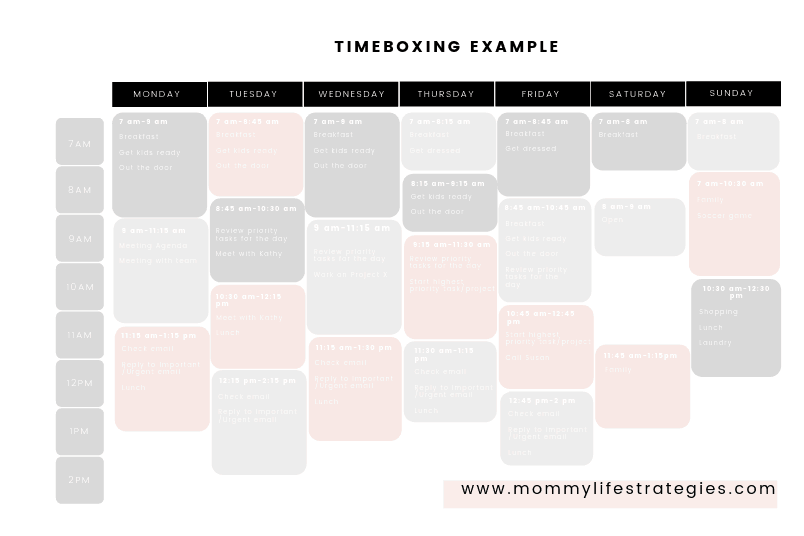
You’re a hard-working mama with a crammed schedule and a to-do list that never ends. You’ve been running on the dreaded list for years. You’ve even tried making your list “better” by buying pretty notepads to write them on.
Maybe you were hoping it would motivate you to get more done?
Maybe the action of crossing off tasks on a long to-do list keeps you writing them?
If yes, then it’s time to let go of the fancy notepad and the instant gratification of checking off your way-to-long to-do list.
It appears that you are getting stuff done but let’s get real, you probably have a ton more to do. So, the high you get from checking off those couple of tasks disappears quickly when you realize it’s only the beginning.
There are so many ways to create a list and some mom bloggers even suggest creating lists within lists within lists which can be very overwhelming and will only add to the stress you’re feeling.
Creating multiple lists can perpetuate unproductive busy work and multi-tasking.
Are you tired of carrying around multiple long lists you can never finish because everything is important?
Are you tired of the disorganization, the overwhelm and lack of clarity that your list is causing?
I hear you. I’ve been there.
I used to have multiple lists floating around. They were on my desk, on the fridge, on the dining table, in my bag, piled on shelves, basically anywhere. None of them were clear or organized. They were lists of anything and everything. Many were time-wasting tasks.
Can you relate?
Not a good situation. So much unnecessary chaos.
You don’t have to stop using lists. What you need is to simplify and prioritize your list.
I have three productivity methods with examples that any overwhelmed mom can use. It will give you the structure you need to truly get stuff done.
No more getting lost in a pile of to-do lists you will never be able to finish.
Let’s take a look at the four productivity methods that will change your life.
The Eisenhower Matrix
You might have heard of it and productivity leaders swear by it. But you don’t have to be a productivity leader for it to work for you. The time commitment to get started is reasonable and it’s a method which helps you identify which tasks are priority and which tasks are just distractions.
How many distractions do you experience every day? If you’re a busy mom, probably many.
The Eisenhower Matrix will help you prioritize easily using a grid and if you’re a visual person like me, you’ll love it.
What is the Eisenhower Matrix?
It’s a grid of 4 quadrants that you can assign your tasks from highest to lowest priority. It goes as follows…
Quadrant 1: Urgent and Important Action to take: Do now
Examples: Doctors’ appointments, household issues like leaking pipes, car issues like your car won’t start and you need to get to work so taking it to the car repair shop is top priority.
Quadrant 2: Not urgent but Important. Action to take: Schedule the task
Examples: Activities like your child’s soccer game or recital, a family trip, coffee with a friend or relative you haven’t seen in a while, grocery shopping, courses, etc.
Quadrant 3: Urgent but Not Important. Action to take: Delegate it
Examples: Emails, online chats, store sales, etc.
Quadrant 4: Not urgent and Not Important Action to take: Remove it. (This is the time-wasting quadrant!)
Examples: Cat videos, social media, gossip, anything that you don’t need, doesn’t have value, wastes your time and provides no return on your time investment.


The Eisenhower matrix is for you if….
- You feel that all tasks and projects are urgent and important
- You struggle with focus
- You frequently create huge to-do lists
- You’re easily distracted throughout the day
- You’re always frustrated and disappointed that your day didn’t turned out as planned
Recommendations and tips to make it work
Either in the morning or the evening (whenever you have the most time), write down everything that comes to mind that you feel you have to do. Call it a “Mind Dump”. Take each task from your “mind dump” and add them to the grid. As you go through this process you will see that you have a lot of tasks that fall into quadrant 3 and 4.
You can do this for daily tasks or weekly. I recommend starting with daily if you’re overwhelmed. Once you get used to the method, you can plan out all your tasks and projects for the week.
You can save yourself a lot of time and energy by doing a little bit of work upfront using this method. However, it’s important to not invest too much time trying to create the perfect list.
If you need to, set a timer for 15-20 minutes to do it. 10 minutes for the mind dump and 10 minutes for assigning tasks to their corresponding quadrants.
That’s it! Now you have a list of truly prioritized tasks that you will be able to complete consistently. No more stress and disappointment.
“My goal is no longer to get more done, but rather to have less to do.”– Francine Jay
ABC Priority Method or ABC List
Like the Eisenhower matrix, it’s a method for prioritizing a list according to level of importance and urgency. “A” for most important and urgent (Must Do), “B” for important but not urgent (Should Do) and “C” for tasks that are both the least important and urgent (Nice to Do).
Basically, it’s the Eisenhower method without quadrant 3, but has subgroups. For example, under each group (A, B, and C), you will have ranks.
You rank each task by their importance. So, for “A” most important and urgent tasks you would place them in order from most difficult to least difficult.
Just like I recommended with the Eisenhower matrix, write down all tasks you need and want to do on a sheet of paper (mind dump). For each task, write an A, B, or C next to it. Using my Free Printable Worksheets, add your top 3 for A, B, and C.
Here’s an example
A: Most Important and Urgent – Must Do
A1-Car doesn’t start – Call the car repair shop asap
A2-Roof is leaking – Call home repair person
A3-Child needs vaccine – Make appointment with doctor
B: Important but Not Urgent – Should Do
B1-Child’s soccer tournament starts in a week – add to calendar and set notification(s)
B2-Family reunion invite – RSVP, add to calendar, and set notification(s)
B3-Running low on food staples – create grocery list. Arrange for pickup, delivery or allot time in calendar for shopping.
C: Least Important and Least Urgent – Nice to Do
C1-Watch Gilmore Girls
C2-Re-decorate the guest room
C3-Browse social media

ABC list is for you if….
- You struggle with differentiating the level of importance of your tasks
- You procrastinate on the most difficult tasks
- You want to simplify your task planning
- You like to prioritize day-to-day and prefer to create a daily list
DOWNLOAD YOUR: Printable Productivity Methods Worksheets
Recommendations and tips to make it work
For each group (A, B, and C) you can add more than just three tasks, but I recommend that for each day you plan stick to your top 3.
If you face a lot of interruptions daily or get overwhelmed easily, start with three and slowly move up by adding one task to groups “A” and “B” every month.
So, in your first month using the ABC method, you’ll have three tasks for each group. On the second month, add four tasks and on the third month add five tasks.
You can adjust how you see fit.
If you really love lists but are finding yourself overwhelmed and you’re not getting anything done, ABC method might be for you.
“Absorb what is useful, reject what is useless, add what is specifically your own.” – Bruce Lee
Timeboxing
What is Timeboxing?
It is what is sounds like. A box or block of time allocated to work on specific tasks. You would take your prioritized to-do list and schedule it in your calendar in blocks of time.
If you feel you’re not making any progress with your current to-do list, try Timeboxing.
Timeboxing process
- Realistically estimate how long your tasks are going to take. For example, you have holiday shopping on your list, and you know from experience that it takes longer than hour so plan you’re shopping trip with a little extra time to ensure you can get it done.
- Choose highest priority tasks (using Eisenhower or ABC methods).
- Leave room for breaks. You can’t be productive if you don’t take breaks. You’re not a machine, so take breaks and lots of them.
- Add a little extra time to each task to account for unexpected events.
- Batch similar tasks for more efficiency (see tips).

Timeboxing is for you if….
- You frequently underestimate your time to complete a task.
- You’re often scattered and don’t have clarity during the day.
- You have a habit of creating huge to-do lists that you can’t finish.
- You are always frustrated and disappointed that your day didn’t turned out as planned
DOWNLOAD YOUR: Printable Productivity Methods Worksheets
Recommendations and tips to make it work
Start with short timeboxes. How much time you want to block for a task will depend on you and circumstances. I recommend blocking no more than 45 minutes for each time block until you master it.
Stop at the end of your timebox. Take a break.
Try timeboxing digitally and on paper. Choose what works best for you.
Block your most rigorous tasks during your peak time. Do you have more energy in the morning, afternoon or evening?
Batch it. What is batching? Batching is doing similar tasks together for efficiency. For example, instead of checking emails frequently during the day allot one or two times a day instead. Timeboxing and Batching go hand in hand, and it will help you optimize your time. Every mom can benefit from this.
Timeboxing is a great way to keep yourself accountable. After doing it for a while, you will get a better measure of time for your tasks. It will only get better as long as you’re consistent.
“Starve your distraction and feed your focus.”– Unknown
Eisenhower Matrix, ABC Prioritization Method and Timeboxing – Why they work…
All three techniques are simple and can be used by any mom at any stage. They work especially well for moms who are inclined to procrastinate and/or who are easily overwhelmed.
They work because the time commitment is small. You’re already short on time so it doesn’t make sense to create a system that’s too complex. It doesn’t need to be complex to be effective! The time invested using these methods are small compared to the time wasted without it.
The benefits of using these priority methods
- Easy to start. The time commitment to get started is reasonable.
- It helps you focus.
- It prevents you from doing unproductive multi-tasking and busywork.
- You will be able manage interruptions better.
- You will help you develop a proactive mindset.
- You will have less to worry about and free up your mental space.
- You will stress less because you will be prepared.
“Simplicity boils down to two steps: Identify the essential. Eliminate the rest.” – Leo Babauta
Know that time management is a skill that takes time to master. No crazy long to-do list is going to magically give you the developed skill of time management.
Also know that it can’t be mastered all the time. Life will happen and your management of time will appear to regress. Don’t let it discourage you! It’s a part of the process. Learn from it and keep moving forward.
Be kind to yourself. Don’t sacrifice the things you enjoy for the sake of productivity. Go ahead and make time in your schedule to do the things you want to do.
Hopefully you will give these methods a try so that you can do all the things that bring you joy. That’s what time management is all about!
To help you succeed, download the printable worksheets I created for each prioritization method to make the transition to a more productive life a smooth one.
Say Goodbye! to the chaos of a huge and messy to-do list. Say Hello! to simplicity and progress.

